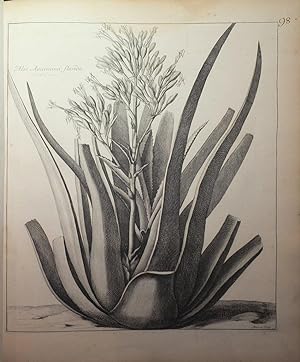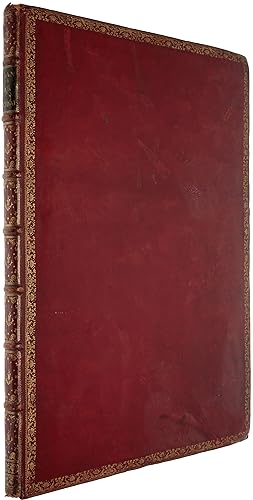dodart dionys (2 résultats)
Type d'article
- Tous les types d'articles
- Livres (2)
- Magazines & Périodiques
- Bandes dessinées
- Partitions de musique
- Art, Affiches et Gravures
- Photographies
- Cartes
-
Manuscrits &
Papiers anciens
Etat
- Tous
- Neuf
- Ancien ou d'occasion
Reliure
- Toutes
- Couverture rigide
- Couverture souple (1)
Particularités
- Edition originale (1)
- Signé
- Jaquette
- Avec images
- Sans impression à la demande
Livraison gratuite
Pays
Evaluation du vendeur
-
Estampes pour servir a l'histoire des Plantes
Edité par Paris: Ca. 1719-1786, 1786
Vendeur : Arader Galleries - AraderNYC, New York, NY, Etats-Unis
Folio. (20 4/8 x 13 inches). Bound without title-page or text, as issued. 160 fine engraved plates, including 6 before letters, by Nicolas Robert, Abraham Bosse and Louis de Chatillon after Nicolas Robert and de Chatillon, with occasional engraved additions and alterations by Jean Marchant, all with early numbering in ink: 1-13, 15-159, and two bis. plates, most with Linnaean bi-nomials added in ink or pencil. Contemporary mottled calf, elegantly rebacked to style in seven compartments, with 6 raised bands, red morocco lettering-piece in one, the others decorated with small gilt tools (corners and edges expertly repaired, endpapers renewed). Provenance: with 18th-century annotations neatly supplying the Linnaean bi-nomials to many of the plates, in pen and ink, or in pencil. A RARE ALBUM OF ROBERT'S MAGNIFICENT BOTANICAL PLATES, PROBABLY BOUND FOR PRESENTATION, not formally published or offered for sale. The original intention was to publish a complete history of plants, including chemical, medical and botanical analyses of all the species. Very rarely offered for sale, and only appears in the collections of major institutions. A full suite consists of 319 engraved plates, and this album of 160 plates includes, in addition to plants from Africa and the East Indies, a large selection of plants native to the Americas, or thought to have been at the time: Hieracium caeruleum Americanum - American blue hawkweed Herba mimosa frutescens - Mimosa punctata L. - found in Texas, Central and Southern America Herba mimosa altera - Mimosa pernambucana L.- found in the West Indies Heliotropicum Americanum - Heliotropicum indicum L.- found throughout Asia Helenium Canadense, Vosacan dictum - Jerusalem artichoke Hellebornie Canadensis, sive Calceolus - Cypripedium album L. - Lady's slipper orchid - North America Muscus marinus americanus reticulatus - a type of sponge Melon vulgaris - Cacumus Melo L. - muskmelon, or cantaloupe melon Palmae nux Indicae cocciferae angulosa - Cocos nucifera L. - coconut Papauer spinosum, Mexicanum - Argemone mexicana L. - Mexican poppy Lilium sive Martagon Canadense , - Lilium superbum L. - Turkscap lily Melocactus Americanus echinatus - Cactus melocactus L. - southern United States, Mexico, Central America, Caribbean Lactuca Canadensis, altissima - Lactuca canadensis L. -Canada lettuce - 3 varieties illustrated Aloe Americana - Algarve americana L. - American aloe - 3 varieties illustrated, including Aloe vera Aster virgineaus augustifolius - New York aster Ananas Acostae Lugd. - Pineapple - South America Althea Indica Aster Canadensis - horse weed, or mare's tail - 2 varieties illustrated Apios americana - potato bean Aquitegita pumita praecox Canadensis - Aquilegia canadensis L. - Columbine Angelica trifolia, Canadensis - Angelica lucida canadensis L. - Sea angelica Apocynum American - Apocynum androsaemifolium L. - Spreading dogbane Astragalus Canadensis - Canadian milkvetch "The original idea for this encyclopaedic undertaking was conceived by Perrault and the proposal was enthusiastically received by Colbert, minister to Louis XIV, although it appears to have actually begun to take shape only when the botanist Denis Dodart (1634-1707) joined the Academie in 1673. His work, Memoires pour servir a l'Histore des Plantes, which was intended to form the introductory volume to this series, appeared in 1675 and contained thirty-nine plates by Robert. In it Dodart lamented the fact that none of the engravings could be in colour, but at least, he assured the reader, all the illustrations in the new series would be drawn directly from life, the artist making every effort to present the plants in their actual dimensions" (Lucia Tongiorgi Tomasi An Oak Spring Flora p 168). "Putting to one side his regular activity of flower painting on vellum in order to concentrate on this project, Robert managed to produce an enormous number of engravings [but at the time of his death the work was incomplete] . The Recueil des plant.
-
Mémoires pour servir à l'Histoire des Plantes
Edité par Sebastien Mabre-Cramoisy at l'Imprimerie Royale, Paris, 1676
Vendeur : SOPHIA RARE BOOKS, Koebenhavn V, Danemark
Membre d'association : ILAB
Edition originale
First edition. 'ONE OF THE GREAT BOOKS IN THE HISTORY OF BOTANICAL ILLUSTRATION' (HUNT) . First edition of "one of the great books in the history of botanical illustration, where all the technical resources of engraving were utilized in presenting the plants as accurately as possible" (Hunt), here accompanied by 5 additional engraved plates. "The idea had originated with Claude Perrault in 1667. When Dionys Dodart (1634-1707) was elected to the Académie in 1673, the proposal took definite shape, and at the end of 1675, the latter's Mémoires pour servir à l'Histoire des Plantes was published by the Royal Press. This volume, a large folio, was planned as the prelude to a vast work whose publication was delayed for many years. Its 39 plates were engraved from drawings by Nicolas Robert (1614-85), made for the most part from life; in the case of several rare plants he was obliged to adapt paintings which he had previously made on vellum at the Jardin du Roi . he was assisted, or perhaps directed, by the engraver Abraham Bosse (1602-76) . In the preface to Dodart's Mémoires the intention of the illustrations is clearly defined. Wherever possible, the plants were to be portrayed life-size; if larger, but not more than twice the size of the page, they would be represented as cut in two; if still larger, some detail would be given full-scale, so that the true size of the plant could be better appreciated. Moreover, all the technical resources of engraving were to be fully utilized. The preface continues: 'Since printing in colour is not employed yet, and since painters waste much time and are not always successful, we thought we could, in future, supply to some extent what was lacking in an engraving, by taking care to indicate, as far as is feasible, the depth of the colour. Thus a distinction would be made between brownish-green and pale green, between white and dark-coloured flowers .'" (Blunt, pp. 111-2). These techniques led to images of such remarkable beauty and quality that numerous authorities agree that Dodart's plates "rank among the best botanical engravings ever produced" (Bridson & Wendel). "The Mémoires contains a methodological introduction and a model showing how to conduct botanical research. Because of Dodart's recommendation of phytochemical analysis, this work marks a new step in botany" (DSB). The first part ('Projet de l'histoire des Plantes', pp. [1]-52) establishes the need for the work and the form of the descriptions and illustrations of the plants, and the second part ('Descriptions de quelques Plantes nouvelles', pp. 53-131) comprises descriptions by N. Marchant and illustrations after Nicholas Robert of 39 species 'dont la pluspart sont rares, & n'ont jamais esté ny décrites, ny figureés' (p. 53), in accordance with the structure proposed in the first part, describing the plants, their attributes, and the sources of the specimens. The frontispiece depicts a meeting of the Académiein the Royal Library at Versailles, with Louis XIV and Colbert in attendance. This is the first published illustration of an assemblyof a learned society. Of the five additional loose plates that accompany this copy, three appear in the work (those on Nn, Ooo [repeated on Ppp] and Qqq), but without the text on the verso. The two remaining plates of Tithymalus Americanus nodifloris and Aster Verbasci folio were apparently intended for the work and engraved by Louis de Châtillon. All are uncut. ABPC/RBH list 8 copies (of which 2 lacked the frontispiece). Provenance: Thomas Philip de Grey, 2nd Earl de Grey (1781-1859), known as The Lord Grantham from 1786 to 1833, Tory statesman and politician and first President of the Institute of British Architects in London (Wrest Park bookplate); acquired from Lucien Goldschmidt, 1964. Bookplate of Arthur & Charlotte Vershbow. Sold Christie's New York, 20 June 2013, lot 487. Christian Huygens was the first to propose that the newly-formed Académie des Sciences publish a natural history. It was to be universal and Baconian, and must study weight, temperature, color, magnetic attraction, the composition of elements, animal respiration, the development of metals, plants and bones. This proposal was in fact one of the reasons which convinced Jean-Baptiste Colbert and his ministers to found the Academy of Sciences. However, it was modified and became two separate projects, dealing with animals and plants. Claude Perrault, a close friend of Huygens, proposed in January 1667 that the Academy publish a natural history of plants. Perrault was inspired especially by Bauhin's Pinax (1623), which Nicolas Marchant had already begun to revise. Perrault identified two ways of organising this study: pure botany, which studies the history of plants through the study of the external characteristics and therapeutic properties of plants, an approach going back to Aristotle's Historia animalium; and natural philosophy which aims, following Theophrastus and Francis Bacon, to research the causes of the medical properties of plants, plant reproduction and plant nutrition. According to Perrault, this approach involves chemical analyses, observation of seeds and pollen under a microscope, experimentation and testing of certain contemporary theories on propagation and generation, including the study of whether the sap circulates in plants like blood in the human body. The Academy at first decided to concentrate on the species of Europe and the Near East, leaving the study of American flora to the Minime priest Charles Plumier. Perrault worried about the continued support of the crown, and decided that a more modest publication has a greater chance of success and should help persuade the government to fund more in-depth research which could lead to a more comprehensive work being published later. Perrault himself took on the project of producing a History of Animals, published the counterpart to the Mémoires des Plantes in 1671 and 1676, the Mémoires pour servir a l'Histoire naturelle des Animaux.



